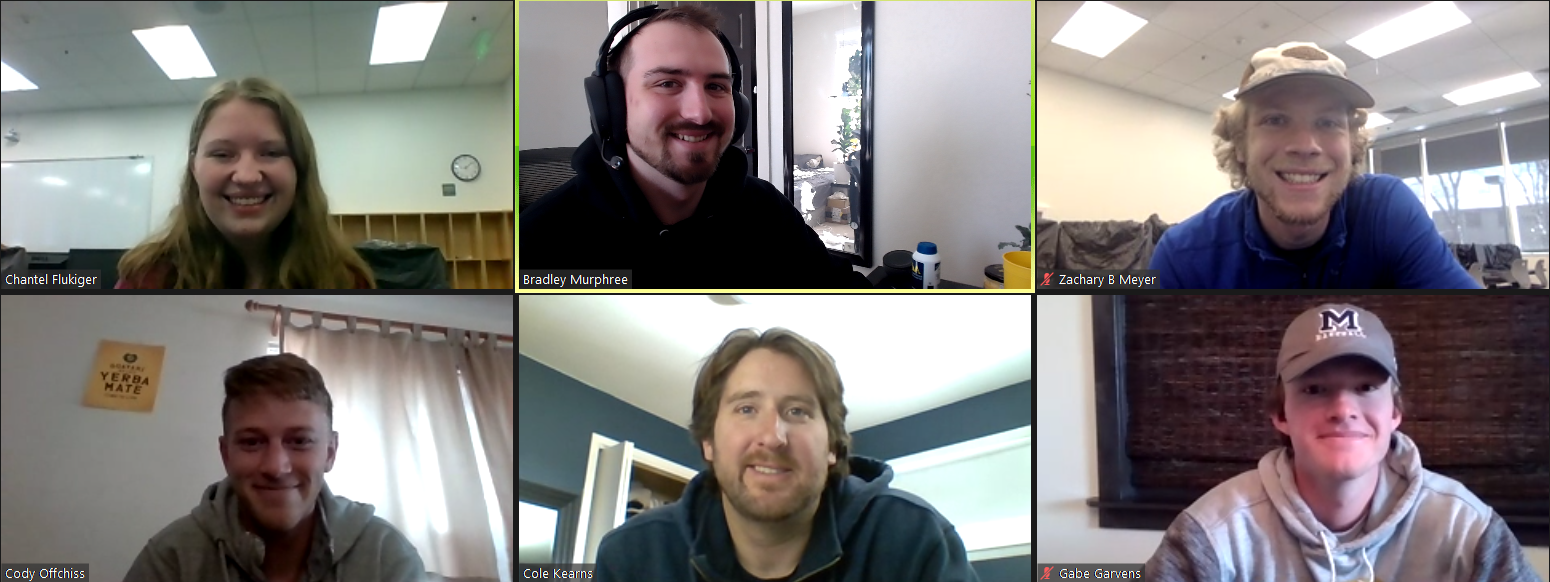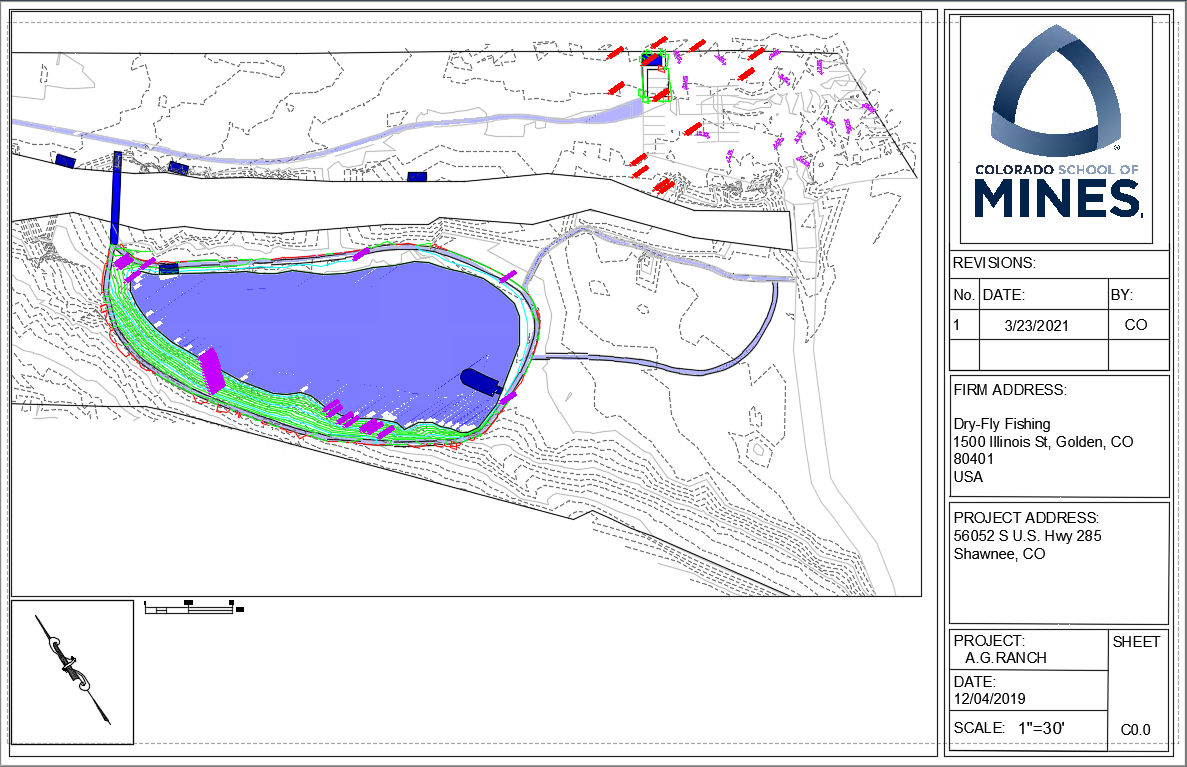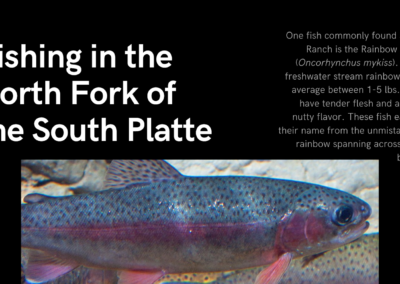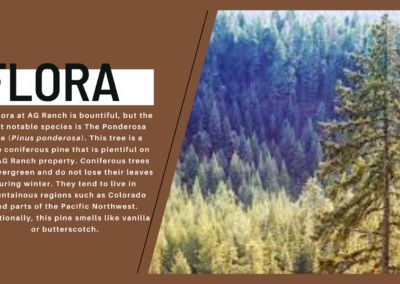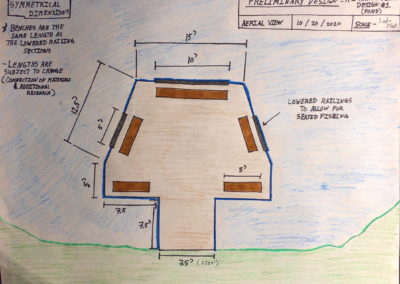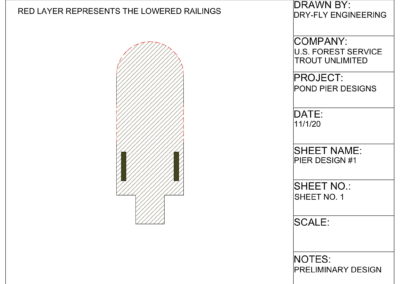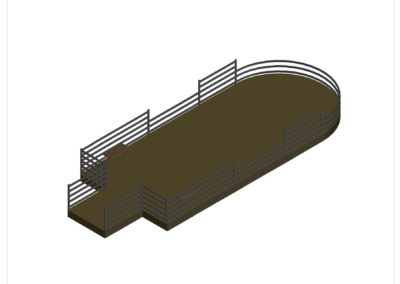ADA Fishing Access and Stream Channel Improvements
Overview
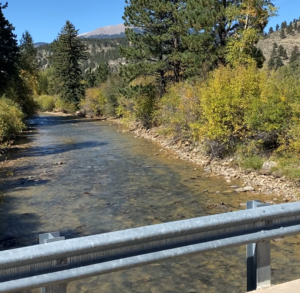 AG Ranch has a rich history: homesteading, railroad, ranch building, and Forest Service activities have all found their home on its land in Shawnee, CO, next to the North Fork of the South Platte River. After its previous use came to an end, the Forest Service saw an opportunity to provide the public with recreational fishing and walking options to people of all abilities, while maintaining appreciation for its past. While leaving the historic ranch house as-is, Dry-Fly Engineering established major improvements to enable this goal. These improvements include ADA accessible trails, river platforms, parking spaces, a pier, and a bridge. Additionally, the team developed interpretive signs to involve users in the space they are in, and laid the groundwork for stream channel design to support the fish population year-round.
AG Ranch has a rich history: homesteading, railroad, ranch building, and Forest Service activities have all found their home on its land in Shawnee, CO, next to the North Fork of the South Platte River. After its previous use came to an end, the Forest Service saw an opportunity to provide the public with recreational fishing and walking options to people of all abilities, while maintaining appreciation for its past. While leaving the historic ranch house as-is, Dry-Fly Engineering established major improvements to enable this goal. These improvements include ADA accessible trails, river platforms, parking spaces, a pier, and a bridge. Additionally, the team developed interpretive signs to involve users in the space they are in, and laid the groundwork for stream channel design to support the fish population year-round.
Below is a slideshow of the overall site plans developed by the team to satisfy this goal, including an overall site plan, parking lot design, and an open area plan.
Live Zoom Chat
Use the link below to join us live from 8:00 – 10:30 a.m. on April 29th.
https://mines.zoom.us/j/99756630065
Team Members
- Chantel Flukiger
- Gabe Garvens
- Cole Kearns
- Zach Meyer
- Bradley Murphree
- Cody Offchiss
The Client
- US Forest Service
- Trout Unlimited
Acknowledgements
- Mikele Painter – U.S. Forest Service
- Leah Shipstead – U.S. Forest Service
- Trout Unlimited
- Lisa Woodward – Project Advisor
- Matt Cooney – Drone Footage
Video
Elevator Pitch
The project at AG Ranch strives to allow an outdoor recreational experience for all abilities, ranging from wader-clad fly fishermen to individuals in wheelchairs. That’s why we designed half a mile of accessible trails and lowered the railings on the platforms and piers for all users to enjoy. We also know that the environment in which we are planning is precious, so we planned to use composite decking and improve fish habitat to not only provide the least-invasive solution, but one that actually improves the natural environment.
Below are a few interpretive signs that will help the users understand and appreciate the site more.
Design Approach
The design process began with a list of wants and needs that the client and team worked together to create:
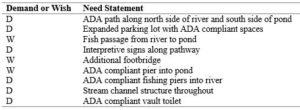
After establishing the needs, the team set to coming up with ideas, which led to some preliminary sketches and conceptual ideas. These slowly became more refined over the course of the school year, with dimensions, shapes, and specifics taking shape. The gallery below shows the iteration of the pier in the pond over the course of the year.
In addition to the sketches, the team utilized several other tools to ensure that they were creating the best project possible, including:
- Site Visits
- The team visited AG Ranch to get a feel for the space, to measure the stream channel, and to capture the drone footage above (and to do some mandatory team building / fishing research).
- They also visited Shawnee Meadows, a nearby fishing ranch that implemented some stream channel improvements.
- And Pine Valley Ranch, an ADA accessible open space in Conifer, CO.
- Regulatory Analysis – These codes and guidelines informed the ideation and design of the project:
- USDA Accessibility Guidebook for Outdoor Recreation and Trails
- USDA Standard Specifications for Construction and Maintenance of Trails
- USDA Sign and Poster Guidelines for the Forest Service
- Federal Highways standard specs FP-14
- EPA CWA Sections 401-402
- Park County Article VII – Use and Development Codes
- ADA guidelines
- Sustainability Analysis – Using the Envision tool, the team learned about some ways to ensure the sustainability of the project:
- Using eco-friendly materials
- Cutting down on the need for utilities by using vault toilets
- Ensuring that the project had a lasting, positive effect for locals and tourists alike
Design Solution
The team presented a solution including an increased capacity parking lot, ADA compliant bathrooms and trails, a pedestrian bridge crossing the river, fishing platforms along the river, a pier over the existing pond, and stream channel improvements to better the fishing at the ranch. Additionally, interpretive signs were designed to catch the interest of users and help them to appreciate the natural and human history of AG Ranch. This design uniquely allows anglers and physically impaired individuals to enjoy the same outdoor space.
Stream Channel
Overall, the proposed tentative stream channel improvements include riffle-pool channel structure to support fish populations during low flow and creating a thalweg on the right bank downstream of the weir, mimicking the current thalweg on the left bank.
Parking Lot
The existing parking lot is approximately 9,000 square feet with a dirt surface. The new lot will relocate the western fence line to expand the parking lot to 20,000 square feet and have 25 spaces with two additional accessible spaces. The accessible spaces will be between the proposed bathroom location and the entrance to the accessible trail. Sizing the proposed lot was done to balance the increased access for multi-use visitors and the quality of recreation on the property as fishermen can be very sensitive to overcrowding.
Trail
The proposed trail improvements largely utilize the existing footpaths created by visitors to the property. Only small portions are rerouted to enter the proposed parking lot and bridge. The existing trails are dirt and vary from 12 to 18 inches in width. The proposed path will be 36 inches wide with a stable, firm surface created by hardpack and stabilizer in accordance with the Forest Service outdoor recreation accessibility guidelines. Fence crossings will either be swing gates or clear openings to enable individuals in wheelchairs to pass through. A small amount of grading will be completed to ensure slope requirements are met.
Bridge
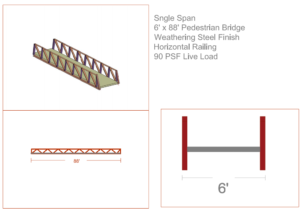
The team worked with Bridge Brothers, a national bridge manufacturer, to come up with a rough design of a prefabricated, single-span bridge. We used a conservative bridge length of 88 feet with a six foot width which is in accordance with ADA accessibility guidelines of 60 inches (ADA accessibility Standard 403.5.3). There will also be a handrail that will stretch the entire length of the bridge.
Pond Pier
The pier on the pond is 14’ by 25’ with an additional 7’ radius arc on the front of the pier. In addition, the pier on the pond has two benches which are 1’ by 6’, a six foot wide opening for ADA access onto the pier, and multiple lowered railing access points. The piers will be constructed out of a durable and composite decking. The railings will be constructed out of steel cabling and composite wood.
River Platforms
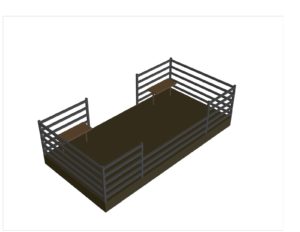 The piers on the stream are 16’ by 8’, with a 6’ wide opening for ADA access. There is also an 8’ span of lowered railing to allow for seated fishing. The pier design also includes two benches which are 3’ by 1.25’. These will be made out of the same materials as the pier on the pond.
The piers on the stream are 16’ by 8’, with a 6’ wide opening for ADA access. There is also an 8’ span of lowered railing to allow for seated fishing. The pier design also includes two benches which are 3’ by 1.25’. These will be made out of the same materials as the pier on the pond.
Next Steps
The end goal for this project is the implementation of the proposed designs. Final stream channel design was delayed due to lack of data, so this aspect of the project will need more time and measurements to conclude with a final design. It needs a team monitoring the flows year round and taking more cross sections of the stream. Other components will require a more in-depth design to create construction drawings for the bridge and piers. Additional work at AG Ranch may include the passage of fish from the stream into the pond and translating information on interpretive signs to braille. When all of the designs are finalized, the Forest Service will apply for grants in order to fund the improvements for AG Ranch. After funding is secured, then the construction process can begin.
Meet the Team
Chantel Flukiger
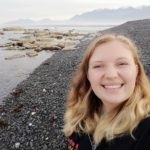 Chantel is an environmental engineering student, originally from Shawnee, CO (this may sound familiar if you remember where AG Ranch is located). She was drawn to environmental engineering when she discovered that she could combine her love for science, people, and the environment all into one career. In her free time, Chantel enjoys reading the Bible, travelling, and doing just about anything outside.
Chantel is an environmental engineering student, originally from Shawnee, CO (this may sound familiar if you remember where AG Ranch is located). She was drawn to environmental engineering when she discovered that she could combine her love for science, people, and the environment all into one career. In her free time, Chantel enjoys reading the Bible, travelling, and doing just about anything outside.
Gabe Garvens
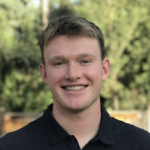 Gabe Garvens is a civil engineering student who is originally from Austin, Texas. Gabe decided to attend Mines in order to pursue a passion in design and follow after his father who is also an engineer. In the summer of 2019, he worked in a geotechnical lab with Atlas, a civil engineering company. During this past summer, he was a virtual intern for Kimley-Horn on one of their Hydrology and Hydraulics teams. He is currently a member of the Colorado School of Mines baseball team and enjoys skiing, mountain biking and fishing in his free time.
Gabe Garvens is a civil engineering student who is originally from Austin, Texas. Gabe decided to attend Mines in order to pursue a passion in design and follow after his father who is also an engineer. In the summer of 2019, he worked in a geotechnical lab with Atlas, a civil engineering company. During this past summer, he was a virtual intern for Kimley-Horn on one of their Hydrology and Hydraulics teams. He is currently a member of the Colorado School of Mines baseball team and enjoys skiing, mountain biking and fishing in his free time.
Cole Kearns
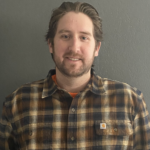 Cole Kearns is a civil engineering student from Dexter, IA. He grew an interest in the civil field after working as a carpenter building decks and home editions. Cole is also a veteran of the United States Navy serving 6 years as an electronics technician. Cole would like to find a job as structural engineer upon graduation.
Cole Kearns is a civil engineering student from Dexter, IA. He grew an interest in the civil field after working as a carpenter building decks and home editions. Cole is also a veteran of the United States Navy serving 6 years as an electronics technician. Cole would like to find a job as structural engineer upon graduation.
Zach Meyer
 Zach Meyer is originally from Monmouth, Oregon. Growing up near the beautiful trees and ocean of the Pacific Northwest gave him a passion to help protect the environment from being ruined by human activity. He enjoys running and singing during his free time. In addition to school and work, he is one of the student leaders in the Christian ministry organization called The Navigators at Mines. He will be pursuing his masters degree in hydrology at Mines next year.
Zach Meyer is originally from Monmouth, Oregon. Growing up near the beautiful trees and ocean of the Pacific Northwest gave him a passion to help protect the environment from being ruined by human activity. He enjoys running and singing during his free time. In addition to school and work, he is one of the student leaders in the Christian ministry organization called The Navigators at Mines. He will be pursuing his masters degree in hydrology at Mines next year.
Bradley Murphree
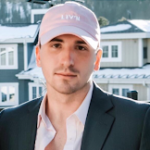 Bradley Murphree is a Civil Engineering student from Westminster, Colorado. Growing up with legos and a father in the industry inspired a love for building. Following in his father’s footsteps, he sought an education at Mines with the help and support of The Daniels Fund Scholarship. Bradley has held multiple leadership positions, and considers himself an activist and philanthropist. In 2020 he held an internship with Cage Civil, and worked alongside the team to design projects like an Amazon Distribution Center and multiple Dollar Generals. Bradley is seeking full-time employment in the field of civil or structural engineering, beginning July of 2021.
Bradley Murphree is a Civil Engineering student from Westminster, Colorado. Growing up with legos and a father in the industry inspired a love for building. Following in his father’s footsteps, he sought an education at Mines with the help and support of The Daniels Fund Scholarship. Bradley has held multiple leadership positions, and considers himself an activist and philanthropist. In 2020 he held an internship with Cage Civil, and worked alongside the team to design projects like an Amazon Distribution Center and multiple Dollar Generals. Bradley is seeking full-time employment in the field of civil or structural engineering, beginning July of 2021.
Cody Offchiss
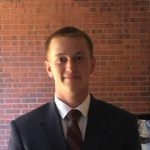 Cody Offchiss is a senior in the civil engineering program at Mines. He was drawn to civil engineering after working in construction during high school. This project aligns with his love of fishing and the outdoors.
Cody Offchiss is a senior in the civil engineering program at Mines. He was drawn to civil engineering after working in construction during high school. This project aligns with his love of fishing and the outdoors.
